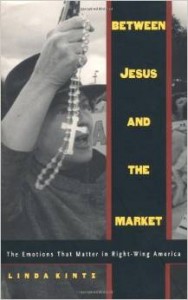
For a new Culture on the Edge series “You Are What You Read” we’re asking each member to answer a series of questions about books — either academic or non-academic — that have been important or influential on us.
4. Name a book that could serve as the perfect foil for your current research project (e.g., an example of a scholarly trend you’re working against).

When I think about a trend in scholarship that I’m working against, I (ironically) consider one of the first volumes that shifted my academic path towards the study of rhetoric, and which remains one of the most influential volumes to my present focus today. Previously in this series I mentioned the pivotal role that Roland Barthes’ Mythologies played early on in my thinking, but in terms of influence, I could just as easily have mentioned Between Jesus and the Market: The Emotions That Matter in Right-Wing America, by Linda Kintz.
Kintz’s work earns a paradoxical place in my mind for the same reason that I feel so conflicted about much of the scholarship on evangelicalism and fundamentalism out today: although often historically incisive and analytically helpful, Kintz writes with a clear agenda to politically defeat her subjects. What strikes me as odd about this position is that almost all scholars who do this contextualize their own political positions as somehow fundamentally different from those that they critique. This, to me, is worth mention because believing that one is fundamentally different from those that they study often proves to be an analytically questionable position.
To be clear, I don’t say this in defense of conservative politics, nor in defense of the notion that we must protect those we study out of some sort of intrinsic respect for or responsibility to them or their positions. Instead, I say it in defense of good analysis, which, as I see it, is the practice of highlighting not only which phenomena get noticed and thus become “data,” but also how these various phenomena are related to one another when viewed across a wide smattering of permutations. To invoke the well-used J.Z. Smith sentiment, the task of the scholar involves recognizing what we regard as familiar and unfamiliar data, looking at why and how we assign these labels as we do, and then doing our best to trouble these categories through comparison and contrast with other aspects of human culture. I would also call this “good analysis.”
Kintz was one of the first to set me in a cognitive tailspin because I found her presumptions quite helpful at the same time that I read them as her biggest analytical liability. In terms of a formative impact on my thinking, I can cite her as one of the first scholars I encountered who talked about right-wing thinking not as a coherent theological premise, but as the process by which familiar and safe images are manipulated to create attractive political positions. The entire volume proceeds to demonstrate the power of conservative rhetoric to very subtly – but effectively – interject specific sorts of persuasive emotional content into American political and popular culture. This was powerful stuff for me. Although I didn’t know it at the time, Kintz was one of my first exposures to critical theory.
On the other hand, though, Kintz’s work presumes that this propensity towards emotional manipulation, if we might call it that, is a specifically conservative trait. The book is filled with references to the dangers, devastations, and ruin that conservatives will foster if they’re permitted to continue their propaganda, and she clearly situates her subjects as psychologically immature people who are ill-equipped to handle the new, different, and unfamiliar.
What she does not consider, unfortunately, is whether these inclinations are human tendencies rather than specifically conservative ones, and it is here that her analysis, in my mind, collapses: Kintz presumes the naturalness of her own position at the same time that she criticizes others for structurally similar propositions. For instance, Kintz doesn’t openly wrestle with the fact that her descriptions of conservatives (self-seeking, narrow minded, intolerant, etc.) are the same critiques that conservatives launch against liberal scholars just like her, leaving us at the end of the day with little more than a “he said, she said” version of events. Although such renderings of events are suitably dramatic, they do little to help us understand how social groups work (except provide us more data on social conflict).
As a scholar trained in both the disciplines of feminist studies and religious studies, I recognize this style and approach as one closer to the feminist studies emphasis on activism and justice through progressive politics. Religious studies scholars often claim to shy away from approaches as politically bold as the one Kintz takes because it lacks the objectivity towards religious phenomena that we say we expect of good scholarship on religion. But this, in my mind, is little more than lip service, for as I discuss in my own book, scholars who study religious groups that we “love to hate,” so to speak, very frequently take time to demonize these groups in the way that Kintz models, couching such a conversation in false-consciousness and other psychologizing arguments so typical of this school of analysis. While those models may, and often do, have some logical weight behind them, they almost always upstage – if not completely overlook – these scholars’ own participation in virtually identical reality-building enterprises that spur on their own politics.
